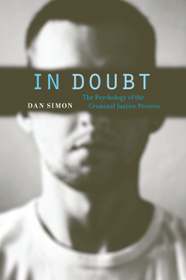Dan Simon's "In Doubt" explores the accuracy of the criminal justice system
by Darren Schenck
Human testimony is habitually incomplete and contains an unknown mix of accurate and erroneous evidence, according to USC Law Prof. Dan Simon. In his new book, In Doubt (Harvard University Press), he reviews the psychological phenomena underlying the criminal justice process and offers concrete recommendations for reform.
At the heart of the criminal justice system are people who, even with the best intentions, introduce human error into the investigatory and adjudicatory processes. Reviewing hundreds of psychological studies, Simon reveals the disquieting fallibility of the evidence we use to send people to prison and even to their death.
“This research is not sufficiently recognized and understood by the people who design the process and govern its operations,” he says. “Because of that lack of knowledge, the system does not work as well as it should.”
 |
| In his new book, Dan Simon reviews the psychological literature and offers recommendations for reforms. Learn more at www.indoubt.net |
Among the types of evidence Simon shows to have significant rates of error are the identification of perpetrators, peoples’ memories for the details of criminal events, and confessions.
“The types of evidence we use in criminal trials, particularly human testimony, is far more complicated, nuanced and susceptible to error than we tend to believe,” Simon says. “And the adjudicative phase is not an ideal process for uncovering those errors.”
By bringing the relevant psychological research to the attention of judges, lawyers and scholars, Simon hopes to enrich the public debate and instigate reform.
“Law enforcement agencies should adopt and follow best practices for conducting investigations,” he says. “For example, there is a detailed protocol for conducting identification procedures, such as double-blind administration and sequential (not simultaneous) presentation of targets.”
Simon adds that all investigative procedures that involve encounters with witnesses should be recorded, and these records should be shared with everyone involved in the process.
Introducing more accurate and transparent evidence, he says, will make verdicts more accurate; build more trust among police officers, prosecutors and defense attorneys; and ultimately reduce both unjust prosecutions and frivolous defense claims.
In class, Simon tries to convey to his students the important difference between law-on-the-books and law-in-action.
“Even the most theoretical legal questions rely on a sound knowledge of the facts,” he says. “That knowledge cannot be accomplished merely by a command over the rules of evidence. Rather, we need a better grasp of how the evidence is produced and how accurate it is.”
Visit the "In Doubt" site to learn more about the book and view conversations with the author.

















